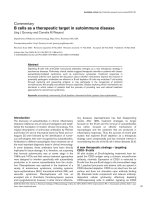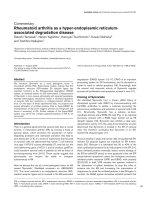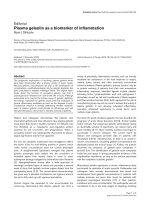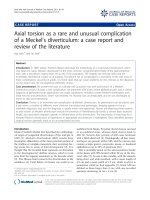Báo cáo y học: " Fetal bone as a foreign body in the urinary bladder: a case report" pot
Bạn đang xem bản rút gọn của tài liệu. Xem và tải ngay bản đầy đủ của tài liệu tại đây (633.79 KB, 3 trang )
Case report
Open Access
Fetal bone as a foreign body in the urinary bladder: a case report
Muhammad Akram Malik
1
*, Abdul Ghaffar Rehan
2
, Iftikhar Ahmad
2
and Tanveer Ahmad
2
Addresses:
1
Department of Urology, Madina Teaching Hospital, Faisalabad, Pakistan
2
Department of Surgery, Madina Teaching Hospital, Faisalabad, Pakistan
Email: MAM* - ; AGR - ; IA - ; TA -
* Corresponding author
Received: 9 September 2008 Accepted: 12 May 2009 Published: 27 August 2009
Journal of Medical Case Reports 2009, 3:8994 doi: 10.4076/1752-1947-3-8994
This article is available from: />© 2009 Malik et al.; licensee Cases Network Ltd.
This is an Open Access article distributed under the terms of the Creative Commons Attribution License (
/>which permits unrestricted use, distribution, and reproduction in any medium, provided the original work is properly cited.
Abstract
Introduction: A wide range of objects have been inserted into the urinary bladder posing a
challenge to urologists for diagnosis and management. Most cases are associated with psychiatric
disorders, senility, intoxication or autoerotic stimulation. The frequency of such cases renders them
important medical conditions of the genitourinary system.
Case presentation: Our case is an unusual one since fetal bone as a foreign body in the urinary
bladder has not been reported in the literature. During dilatation and curettage, fetal bone migrated
into the bladder wall of a 37-year-old woman and was endoscopically removed 7 years later.
Conclusion: A foreign body in the urinary bladder is rare and in most cases are self-inserted.
Iatrogenic insertion is relatively rare especially during gynecological intervention. The presence of a
foreign body in the bladder should be kept in mind when dealing with unusual cases of lower urinary
tract symptoms.
Introduction
Foreign bodies are common in the upper gastrointestinal
and respiratory tract. However, foreign bodies in the
urinary bladder are relatively rare. The variety of foreign
bodies found inserted into or externally attached to the
genitourinary tract is extremely varied and has included
fish hooks, metal rods, hair pins, screws, pellets, wires,
wooden sticks, pieces of fish and telephone cables [1-3].
Most cases are asso ciated with psychiatric disorders,
senility, intoxication or autoerotic stimulation [4]. Such
cases are important additions to the medical conditions of
the genitourinary system [5]. Most patients are usually too
ashamed to admit to the introduction of a foreign body
and usually present with dysuria, uri nary frequency,
hematuria, suprapubic pain, swelling of the penis and
external genitalia, extravasations or abscess formation [6].
Diagnosis is based largely on history and clinical examina-
tion. However, radiological and cystoscopic studies are
often required to confirm the diagnosis and to plan
management [7]. The management includes extraction of
the foreign body and prevention of long-term complica-
tions in addition to assessment of patient motivation. In
this case report, we present a rare and probably the first
report of this type of foreign body in the urinary bladder.
Page 1 of 3
(page number not for citation purposes)
Case presentation
A 37-year-old woman presented to our outpatient depart-
ment with hematuria, increased urinary frequency and
suprapubic pain for the previous 7 years. Her menstrual
history revealed irregularity with no conception during
this period. She underwent dilatation and curettage 7 years
previously for amenorrhea of 4 months’ duration. Her
gynecological and abdominal examinations were unre-
markable. Ultrasonography of the kidney, ureter and
bladder (KUB) showed normal upper urinary tracts and
a 2 × 3 cm irregularly shaped stone at the trigone, which
did not move with side-to-side movement of the patient.
X-ray KUB showed an irregular radio-opaque object in the
pelvis 2 cm above the symphysis pubis (Figure 1). On
cystoscopy, a small hard object was found to be projecting
inside the bladder at the level of the ureteric bar close to
the left ureteric orifice. Part of the object was inside the
bladder and the remainder embedded in the bladder wall.
A gentle attempt with forceps and stone punch failed to
retrieve the object. Resection of the mucosa by resecto-
scope had to be performed and pieces of the hard object
were removed endoscopically. The object was palpable per
vaginally during the procedure with intact mucosa.
Macroscopically, the pieces looked like bony or wooden
material with overlying calcium deposition (Figure 2). The
patient was catheterized for 5 days. Postoperative recovery
was uneventful and urinary symptoms were relieved after
2 weeks. Histopathology proved the objects to be pieces of
bone showing trabeculae, fibrocollagenous tissues and
inflammatory cells.
Discussion
Every conceivable object has been inserted into the
bladder presenting a challenge of diagnosis and manage-
ment to the urologist [8]. The most suitable method of
removing the foreign body depends upon the size and
mobility of the object in the genitourinary tract [9].
Numerous cases of foreign bodies of unusual nature in the
urethra and bladder have been reported in the literature
[9]. Such foreign bodi es were introduced for sexual
stimulation or during intoxication.
Shame and humiliation may prevent these patients from
volunteering the reason. Even when the objects are
extracted and presented to the patients, the majority
deny any knowledge. Various methods for removal of
foreign bodies from the bladder have been described
including cystoscopy, suprapubic cystostomy and injec-
tion of solvents. Endoscopic retrieval is the treatment of
choice. Grasping instruments may be required including
grasping forceps, stone basket, stone punch and other
modified instruments [1,3,9].
In our patient, we suspected a foreign body in the urinary
bladder on the basis of symptoms and radiol ogical
studies. This may be the first case where fetal bone has
Figure 1. X-ray of the kidney, ureter and bladder showing
radio-opaque irregular shadow in the posterior wall of the
bladder.
Figure 2. Bony pieces after removal from the bladder.
Page 2 of 3
(page number not for citation purposes)
Journal of Medical Case Reports 2009, 3:8994 />migrated into the bladder and was retained in the urinary
bladder wall for 7 years, as no such case has been reported
in the literature.
It is thought that injury to the bladder wall occurred
during attempted abortion and bony pieces penetrated
into the bladder. The perforation sealed itself on the
vaginal side and the patient suffered symptoms due to the
presence of the foreign body in the bladder wall.
The presence of bone in the urinary bladder and its
removal have been reported by Garcia Rojo et al. in 1993
[10], however that object was self-introduced. Iatrogenic
introduction of a foreign body into the bladder has been
reported in the literature but this may be the first reported
case of iatrogenic introduction of fetal bony parts [11-13].
Attempted abortion leading to bladder and vaginal
perforation and the presence of fetal bones in the bladder
for more than 7 years reflects the health care system in
Pakistan and possibly other developing countries.
An unqualified “Dai” (birth attendant) is usually involved
in deliveries, abortions, dilatation and curettage in remote
areas of Pakistan. Perforation of the uterus, bladder,
intestine and rectum is not an uncommon complication
under these circumstances. Trained birth attendants,
female health workers and female health visitors have
been trained and appointed in rural areas of the country
but much planning and work is still required to improve
the obstetrical and gynecological services in these areas.
Conclusions
Foreign bodies in the urinary bladder are rare. Radiological
investigations are usually required for their management
and endoscopic removal is the treatment of choice.
Iatrogenic insertion reflects the deficiency of trained health
care professional in remote areas of Pakistan. World
organizatio ns should help developing nations in the
provision of better health care facilities.
Abbreviation
KUB, kidney, ureter and bladder.
Consent
Written informed consent was obtained from the patient
for publication of this case report and any accompanying
images. A copy of the written consent is available for
review by the Editor-in-Chief of this journal.
Competing interests
The authors declare that they have no competing interests.
Authors’ contributions
MAM contributed to the management of the patient and
writing this case report manuscript. AGR contributed in
revising the manuscript and gave final approval of the final
version. IA contributed to the management of the patient
and revising the manuscript. TA contributed to the
management of the patient and revising the manuscript.
Acknowledgements
The authors acknowledge the financial support provided
to the patient by the Chairman, Madina Foundation, Mian
Muhammad Hanif, for hospital expenses, medicines and
food. The authors also acknowledge the following doctors
for their contribution in managing the patient, diagnosis
and preparation of this case report: Zulifqar Ali, Irshad
Ahmad and Zikria Rasheed of the Department of Surgery,
Madina Teaching Hospital, Faisalabad, Pakistan; Saadia
Hameed of the Department of Pathology, Madina Teach-
ing Hospital and University Medical College Faisalabad,
Pakistan; and Rana Qaiser Mehmood of the Department
of Pathology, Punjab Medical College, Faisalabad,
Pakistan.
References
1. Van Ophoven A, deKernion JB: Clinical management of foreign
bodies of the genitourinary tract. J Urol 2000, 164:274-287.
2. Ayyildiz A, Gurdal M, Nuhoglu B, Ersoy E, Huri E, Germiyanoglu C:
A foreign body self-inserted via the urethra into the bladder:
pocket battery. Int Urol Nephrol 2003, 35:251-252.
3. Gonzalgo ML, Chan DY: Endoscopic basket extraction of a
urethral foreign body. Urology 2003, 62:352.
4. Rosenthal M, Berkman P, Shapira A, Abramovit z J: Urethral
masturbation and sexual disinhibition in dementia: a case
report. Isr J Psychiatry Relat Sci 2003, 40:67-72.
5. Adams GW Jr, Hudson HC: Routine prostatitis? A case report of
long-term foreign body in the prostatic urethra. J Urol 1986,
136:682-683.
6. Aliabadi H, Cass AS, Gleich P, Johnson CF: Self-inflicted foreign
bodies involving lower urinary tract and male genitals. Urology
1985, 26:12-16.
7. Barzilai M, Cohen I, Stein A: Sonographic detection of a foreign
body in the urethra and urinary bladder. Urol Int 2000, 64:178-
180.
8. Banerjee A, Rao S, Khanna SK, Narayanan PS, Gupta BK, Sekar JC
et al.: Retained foreign bodies in adults. Ann Urol (Calcutta)
2001, 35:277-279.
9. Rehman NU, Elliott SP, McAninch JW: Self-inflicted male urethral
foreign body insertion: endoscopic management and com-
plications. BJU Int 2004, 94:1051-1053.
10. Garcia Rojo D, Vicente Palacio E, Calvo Mateo MA, Vila Barja J,
Montesino Baillo A, Soler Rosello A: [Intravesical foreign body.
Post traumatic migration of autologous bone fragment.] Arch
Esp Urol 1993, 46:905-907.
11. Kochakarn W, Pummanagura W: Foreign body in the female
urinary bladder. 20 years experience in Ramathibodi hospital.
Asian J Surg 2008, 31:130-133.
12. Habermacher G, Nadler RB: Intravesical holmium laser frag-
mentation and removal of detached resectoscope sheath tip.
J Urol 2005, 174:1296-1297.
13. Oliver Llinares FJ, de Diego Garcia F, Balanco Brunet JL, Cruz
Benavides C, Yarez Angulo JM: Intravesical foreign body caused
arising from ureterostomy protective resin gum. Arch Esp Urol
1995, 48:847-848.
Page 3 of 3
(page number not for citation purposes)
Journal of Medical Case Reports 2009, 3:8994 />









